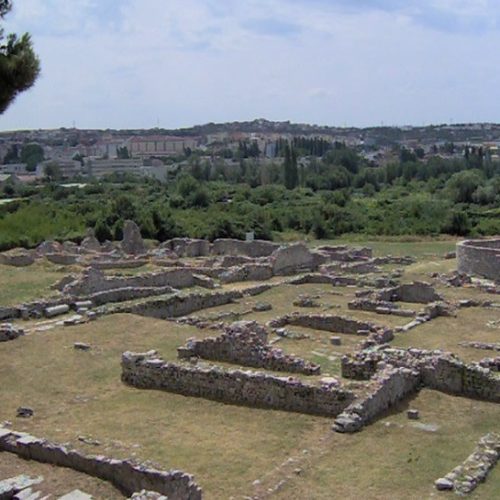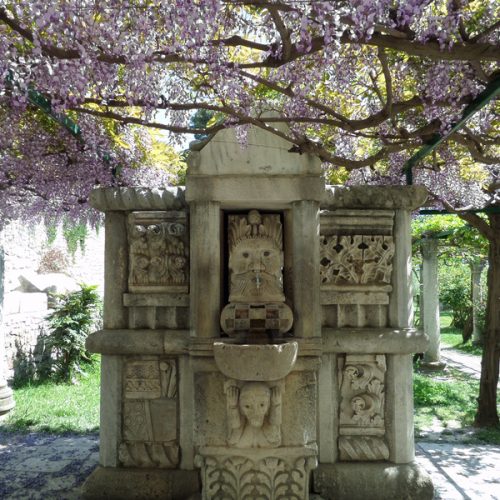Između Splita i Seget Vranjce, udaljeno od Splita 5 km
Povijest grada
Napisati sažeti prikaz povijesti Solina, nekada glavnoga grada jedne rimske provincije, i opisati neke njegove važne spomenike, privlačan je, ali i vrlo odgovoran zadatak. Dobro je, naime, poznato da je Salona grad koji se na izmaku antičkog svijeta gasi, nestaje i više se ne obnavlja. U srednjemu vijeku, gradski teritorij Salone, čitav nekadašnji salonitanski ager, ustrojen potkraj republikanskoga doba, nalazi se između triju važnih središta koja se međusobno često sukobljavaju: između gradova Trogira i Splita i kliškoga kaštela, koji je dugo bio u vlasti hrvatskih velikaških porodica, a potom Turaka. To određuje sudbinu i bivšega grada Salone – Solina i čitava njegova područja.
Znamenitosti
Od antičke Salone, nekad glavnog grada rimske provincije Dalmacije o čijoj veličini, blagostanju i raskoši svjedoče impozantne zidine s kulama, i vratima, forum s hramovima, amfiteatar, groblja sa salonitanskim mučenicima (Manastirine, Kapljuč, Marusinac) do vremena hrvatskih vladara, kada je Gospinim otokom kročila kraljica Jelena i krunidbe kralja Zvonimira u Šupljoj crkvi 1076. godine, Solin je uistinu grad spomenik…
Amfiteatar
Na sjeverozapadnome kraju salonitanskoga gradskoga područja, naknadno opasanog zidinama, sagrađen je amfiteatar, izravno uklopljen u obrambeni sustav grada. Njegovi su ostaci relativno vrlo dobro sačuvani, (doduše znatno slabije od onoga drugoga u Hrvatskoj, u Puli), pa je po njima E. Dyggve napravio poznatu rekonstrukciju. Prva istraživanja, potkraj prve polovice 19. stoljeća, pokrenuo je F. Carrara koji je, osim tog pothvata, zaslužan za prvi i vrlo temeljit pristup gradu i arheološkim istraživanjima. On je, naime, 1850. godine objavio knjigu o topografiji Salone i dotadašnjim iskopavanjima koja je i danas vrlo vrijedna i upotrebljiva. Poslije mnogo godina ponovno se istraživalo u amfiteatru u tri navrata: prije i tijekom Prvog svjetskog rata (F. Bulić), a zatim 1929. godine u okviru proučavanja toga zdanja za objavljivanje u velikoj monografiji tiskanoj 1932. godine (E. Dyggve). Napokon je početkom osamdesetih godina istraživao F. Oreb u prilici zaštitnih radova na uređenju arene.
Dyggve pretpostavlja da je amfiteatar projektiran od rimskih arhitekata koji su i drugdje gradili slične građevine, i da je sagrađen u drugoj polovici 2. stoljeća poslije Krista. Danas ga vidimo, doduše, sačuvana samo u donjim slojevima masivnih zidina, dobrim dijelom obnovljenim i rekonstruiranim poslije Drugog svjetskog rata, pedesetih godina. U mletačko doba bio je i namjerno rušen da bi se spriječilo utvrđivanje turskih četa koje su tada, u 16. i 17. stoljeću ratovale s Mlečanima. Potom je služio kao “kamenolom” iz kojeg se, kao i na mnogim drugim mjestima, uzimalo građevno kamenje.
Pretpostavlja se da je mogao primiti oko petnaestak, pa čak i nešto više tisuća posjetitelja. Zbog brza i jednostavna dolaska i napuštanja gledališta, graditelji su konstruirali dvostruki sustav komunikacija: radijalni, u odnosu na elipsu čitave građevine i kružni, u odnosu na razine u visini redova postavljenih sjedišta. Takav je način danas vrlo čest na velikim sportskim stadionima. Zbog njegova položaja, uza sjevernu stranu gradskih zidina, a dijelom i uza zapadnu, glavni su mu ulazi bili po svoj prilici na jugu i na istoku, pa se donekle odstupilo od sheme s po dva ulaza na uzdužnoj osi istok – zapad. Svojim sjevernim dijelom naslanjao se na povišeno zemljište, pa je dio zidova postavljen na tupinu (to se i danas vidi) bio bez podgrađa kakvo je na ostalim stranama. Južna je strana, a također i dio zapadne i istočne, imala tri kata: dva s arkadama, a treći s pravokutnim prozorima.
U neposrednoj blizini amfiteatra, s juga, bilo je groblje poginulih gladijatora koji su se borili u areni. Iz pogrebnih natpisa doznaje se za njihova imena, porijeklo, domovinu i borilačku specijalnost.
 Hrvatski
Hrvatski English
English Français
Français Deutsch
Deutsch Čeština
Čeština
































